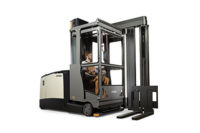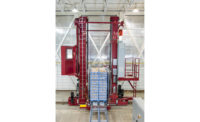Located just off Interstate 70, one hour east of Indianapolis and one hour west of Dayton, Ohio, is Cambridge City, Ind. (CCI). As of July 2015, it’s also now home to SugarCreek’s new 418,000-square-foot facility, what is said to be one of the nation’s first commercial-scale sous vide operation.
The state-of-the-art CCI plant was built for the future, complete with three high-volume cooking halls, infrared impingement ovens and the Industrial Internet of Things (IoT). Plus, it became SQF 3-certified after just three months of operation. That’s why SugarCreek, Fairfield, Ohio, was named Refrigerated & Frozen Foods’ 2016 Refrigerated Foods Processor of the Year. (CLICK HERE for more about SugarCreek and what separates this producer of ready-to-eat product lines from the pack).
Less is more
SugarCreek purchased the then 78,000-square-foot CCI facility in 2012 from Really Cool Foods, an organic prepared foods manufacturer. Shortly thereafter, it acquired 90 acres east of the plant, added on 340,000 square feet, including new drains, a 70,000-gallon pit, three dissolved air flotation systems, one micro system, a 250,000-gallon equalization tank, a walk-on ceiling, catwalks and mezzanines and the ability to produce 4 million pounds of product a week. One hall pushes out meatballs and sausage patties while another hall is dedicated to sous vide products.
At the time of Refrigerated & Frozen Foods’ visit, the CCI facility was producing sous vide chicken.
First, the chicken goes through a flame searer, which cooks the protein enough to develop color or char marks. Then, product is wheeled into the sous vide hall, loaded onto a conveyor and emptied into one of the trays. A robotic crane pulls the tray up, pushes it around the carousel and deposits it into an empty tank that is then filled with water set to specs by customer. The sous vide line houses 10 tanks with 39 trays per tank. Each tank holds 4,500 gallons of water and 10,000 pounds of dense product, depending on product type. Each tray weighs 880 pounds.
“From the top of the tank to the bottom is all within a few tenths of a degree. It’s very precise. There’s no hot and cold spots,” says Rick Matulis, director of research and development. “Once we put the water in there, it actually circulates like a whirlpool, so it’s constantly turning over.”
The autonomous sous vide line also features an alarm that sounds when it’s time to “sacrifice” one of the packages in the middle by installing a probe that monitors temperature throughout the refrigeration process.
“The probe tells us our finished internal temperature, which is compared to the cooking recipe,” Matulis says. “Once it hits the endpoint cooking temperature and it’s been in that temperature for the designated period of time, then the cooking cycle stops and the chilling cycle begins. The length of the cooking and chilling cycle depends on the size of the protein and what the cooking recipe calls for.”
Once the chilling cycle ends, the product is unloaded and conveys into the packaging room.
Before and after every cycle, each tray enters the line’s commercial “dishwasher” and undergoes a thorough washing and sanitizing at 180°F.
“The whole process takes about 10 minutes from the first pickup of the tray until it gets all the way back around and gets washed,” says Belinda Bergen, plant quality technician.
Energy efficient features of the CCI plant include LED lighting and reusable water.
For example, “the steam we use [on the sous vide line] is used throughout the plant. My steam and somebody else’s steam is all on the same line,” adds Bergen. “And, the water we have in our storage tanks is recycled. It does not get dumped. It’s constantly recycled.”
Meanwhile, the meatball line consists of a room where meatballs are formed and cooked with steam and then cooked in an impingement oven. This hall produces about 2,600 pounds of meatballs per hour, and when up and fully running (by press time), it will pump out about 4,000 pounds of meatballs per hour.
Looking ahead, the CCI plant will house a separate room for packaging materials, hybrid hookups for compressed natural gas-powered trucks, a prep room and a training and learning center. John G. Richardson, chairman and CEO, also purchased two farmhouses situated on the west side of the CCI plant, as well as 90 acres adjacent to the facility, just in case.
With the new CCI plant also comes a new assortment of packaging possibilities through SugarCreek’s packaging arm, Wingate Packaging, Blue Ash, Ohio. From standard bacon L-boards and high-resolution printed folding cartons to 2.5-ounce standup resealable pouches and 35-pound industrial-sized packs, the CCI plant can provide printed flexible films, rigid trays, modified atmospheric packaging and a full range of supply chain solutions.
Exercising IoT, aggressive wastewater management, food safety
The CCI plant installed a fully integrated technology solution that connects machines with employees to improve food and employee safety.
How it works is, all employees wear a hard hat equipped with a microchip RFID tag that follows employees around the facility and tracks their motions, steps and whereabouts within the facility. Every room boasts 4-5 grey boxes, or data wavepoints, which collect and house all of the tracking data.
“Why is this important?,” asks Dan Sileo, vice president of manufacturing. “It’s really a total and complete information system that helps us manage our business to the best of our ability. It’s how we ensure that our customer gets what they need while maintaining a safe environment.”
The CCI building also boasts an aggressive wastewater treatment center, complete with new flooring, drains and bio systems. A 90,000-gallon tank holds bags of plastic pellets called media that grow bacteria. Behind this tank is a 250,000-gallon equalization tank that allows SugarCreek to chill water and settle out the pH. Then, a 70,000-gallon tank boasts three variations of flagulation units to pump gas within the facility.
“Our limits are just shy of potable water. It’s very clean,” adds Sileo.
CCI received SQF 3 certification, even after being open just a few months, and boasts a USDA office and assigned USDA parking spots on-site.
The other thing different about the CCI facility vs other SugarCreek ones is the work system, according to Sileo.
“The lines are run by technical experts who know how the machines work and how to fix them,” he adds. “It’s very different than just having operators push a button and then call for help every time something goes wrong.”
Making meal solutions that matter
SugarCreek is in a period of rapid growth, according to Richardson.
“With our new, expanded facilities, we will be able to offer higher volumes and value-added cooked vegetables. Sustainability, safety/traceability, equipment and technology are always our focus as ways to improve efficiency on all levels and allowing us to work smarter. Our IoT-enabled ‘Smart Factory,’ CCI, will improve not only worker safety, but [also] productivity. High-performance work team structures will allow us to operate with fewer but more savvy employees and offer long-lasting careers,” he adds.
Go to http://bit.ly/1cMSPlA to check out the full photo gallery of the Cambridge City, Ind., plant tour.

















